熱電変換材料 _ Thermoelectric Materials
ペルチェ効果そしてゼーベック効果を示す熱電変換材料は生活の場で多く使われています。その多くは有機材料や金属材料です。この熱電変換材料は移動媒体や工業施設からの「排熱」を電気エネルギーへ変換する素材としても注目されています。既存の有機材料や金属材料では耐えられない高温環境下においても使用可能な酸化物熱電変換材料の探索を挑戦しています。我々はp型およびn型酸化物半導体を探していますが、新素材が見出されたときには熱電モジュールの開発と実用化を進めます。
Many thermoelectric materials that show Peltier and Seebeck effects are used in our daily life. Most of them are organic and metallic materials. These thermoelectric conversion materials are also attracting attention as a material for converting "waste heat" from transfer media and industrial facilities into electrical energy. We are challenging the exploration of oxide thermoelectric conversion materials that can be used in high-temperature environments where existing organic and metallic materials cannot withstand such conditions. We are looking for p-type and n-type oxide semiconductors, and when new materials are found we will proceed with the development and practical application of thermoelectric modules.

リチウムイオン二次電池正極材 _ Cathode Materials for Lithium-ion Battery
リチウムイオン二次電池はモバイル機器から自動車・航空機などの移動媒体まで広く使われています。我々はリチウムイオン二次電池を構成する正極材料に関心を持ち、多元系複合酸化物の物質探索を進めています。対象とする結晶構造は層状岩塩型、スピネル型、オリビン型と呼ばれるものが中心です。これらの遷移金属イオンのサイトを多元素置換して新しい物質を探索しています。最終的に電池特性を評価する際には、ボタン型電池(CR2032型)を作製して充放電特性などの測定を進めています。
Lithium-ion secondary batteries are widely used in mobile devices, automobiles, aircraft, and other transportation media. We are interested in cathode materials for lithium-ion batteries, and are exploring multinary oxide materials. Our target are mainly layered rock salt, spinel, and olivine-type crystal structures. We are exploring novel materials by substituting multi-element for transition metal ion sites in these structures. For the final evaluation of battery characteristics, we are making coin-type batteries (CR2032 type) and measuring their charge-discharge and other characteristics.

リチウムイオン二次電池用固体電解質 _ Solid Electrolyte for Lithium-ion Secondary Batteries
全固体電池は安全性、寿命、容量などの点で既存のリチウムイオン電池の性能を上回ると期待されており、特に硫化物系の研究が進んでいます。しかし材料に含まれる硫黄成分から有毒ガスが発生するリスクもあります。2023年に藤本研究室では、全固体リチウムイオン電池の基幹部材として幅広い温度域で高いイオン伝導度と安全性を兼ね備えた酸化物系固体電解質 Li2-xLa(1+x)/3M2O6F (M = Nb, Ta)を発見しました(プレスリリースはこちら)。この材料は大気中で安定であることに加え、既報の酸化物系固体電解質よりも高いイオン伝導度を示します。我々はこの材料の性能向上に加えて、新たな材料発見に向けた研究を進めています。
All-solid-state batteries are expected to improve upon the performance of existing lithium-ion batteries in terms of safety, lifespan, and capacity, with particular research progress being made in sulfur-based materials. However, there is also a risk of toxic gas generation due to the sulfur components in the materials. In 2023, our laboratory discovered an oxide-based solid electrolyte, Li2-xLa(1+x)/3M2O6F (M = Nb, Ta), which exhibits high ion conductivity and safety over a wide temperature range, making it a promising candidate for the core component of all-solid-state lithium-ion batteries (press release available at here). This material is stable in air and exhibits higher ion conductivity than previously reported oxide-based solid electrolytes. We are continuing our research to further improve the performance of this material and to discover new materials.

センサー材料(エネルギー関連材料) _ Sensor Materials (Energy-Related Materials)
今後、燃料電池を搭載した自動車が増えてくると、水素供給ステーションを増やしていかなければなりません。家庭用のガス漏れ検知器と同じように、水素をクリーンエネルギー燃料として安全利用するためには水素ステーションのように水素を取り扱う場所で電気的・光学的に水素ガスを高速に漏洩を検知するセンサーが必要です。当研究室では複数の酸化物に着目し、材料創製、成膜、センサー特性評価にチャレンジしています。
As the number of automobiles equipped with fuel cells increases in the future, it will be necessary to expand the number of hydrogen supply stations. Similar to gas leak detectors used in homes, sensors that can rapidly detect hydrogen gas leaks using electrical or optical methods are essential for the safe use of hydrogen as a clean energy fuel at hydrogen stations and other locations where hydrogen is handled. In our laboratory, we are focusing on multiple oxides and challenging ourselves in material creation, film formation, and sensor characterization.
NOx浄化触媒およびCO2吸着材の探索(環境関連材料)_ Exploration of NOx purification catalysts and CO2 adsorbents (environment-related materials)
酸性雨の原因である窒素酸化物は未だアジアでは増加しており、NOx触媒は必要不可欠です。現在使用されている触媒には貴金属が含まれていますが、目標は貴金属無担持での高活性NOx浄化触媒の創製・高機能化です。当研究室で着目している材料についてガス吸着メカニズム・触媒能を、分光学的手法などにより評価しています。また、合成技術を工夫して対象材料の高機能化にも取り組んでいます。これまでの知見を活かし、最近ではCO2吸着材の探索を始めています。
Nitrogen oxides, which cause acid rain, are still increasing in Asia, making NOx catalysts indispensable. Currently used catalysts contain precious metals, but the goal is to develop and enhance high-performance NOx purification catalysts that do not require precious metals. In our laboratory, we are evaluating the gas adsorption mechanisms and catalytic performance of materials of interest using spectroscopic techniques. Additionally, we are working to enhance the functionality of target materials by optimizing synthesis techniques. And, based on our accumulated knowledge, we have recently begun exploring CO2 adsorbents.
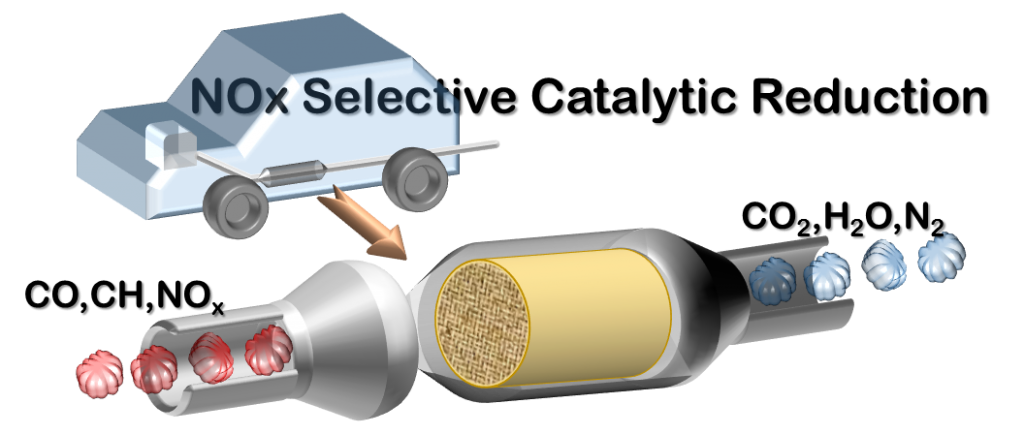
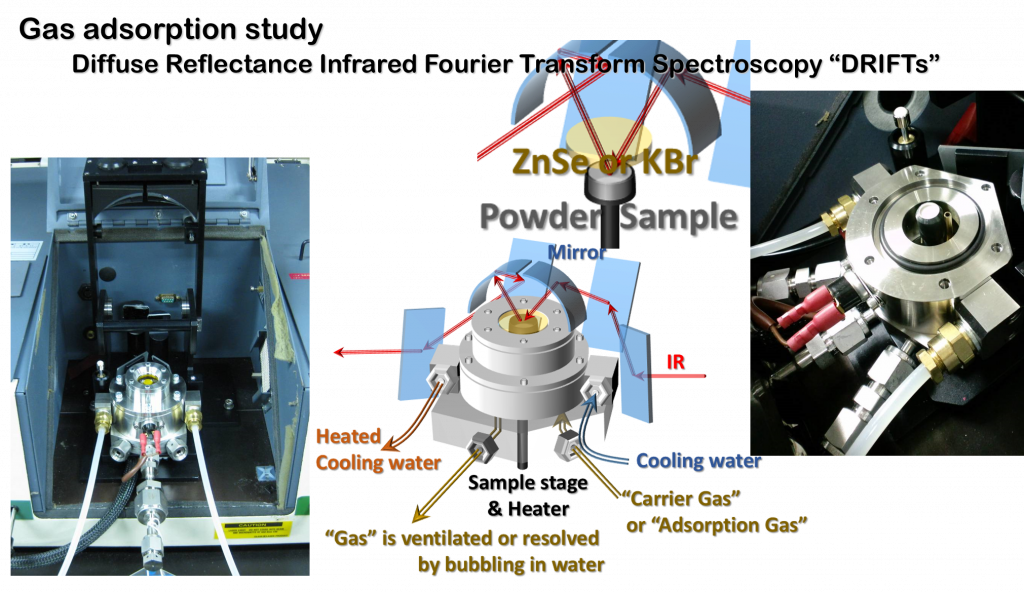
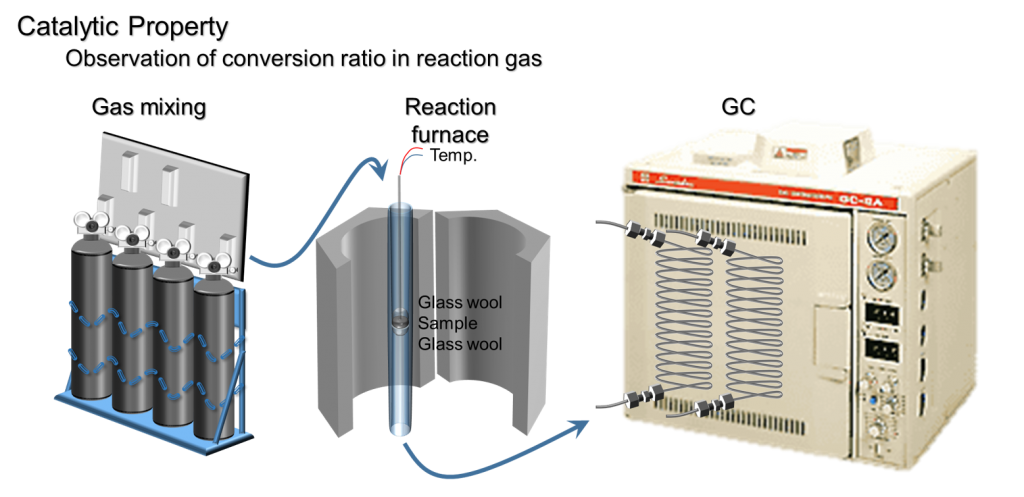
光触媒(環境関連材料) _ Photocatalysts (environmental materials)
光触媒は人工光合成による水素ガスの生成、シックハウス症候群を引き起こす有害ガスの分解浄化など、広く応用されています。光触媒の性能向上として求められる要素に「可視光応答」があります。我々が有する様々な合成プロセスを駆使し、高活性光触媒材料を合成しています。
Photocatalysts are widely used for applications such as hydrogen gas generation through artificial photosynthesis and the decomposition and purification of harmful gases that cause sick building syndrome. One of the key factors required for improving the performance of photocatalysts is “visible light responsiveness.” We are synthesizing highly active photocatalytic materials by utilizing our various synthesis processes.
蛍光体 _ Luminescent materials
蛍光体は、外部から電子線や紫外線などエネルギーを与えるとそれを主に可視光として放出する物質のことで、現在照明などに幅広く利用されています。蛍光体の中で特に夜光塗料などとして利用されている、外部からエネルギーの供給を遮断しても長時間発光を示す残光蛍光体の研究を行います。蛍光体の母体の探索と、発光中心イオンの種類や量の探索を総当たり的に行うことで、発光強度の大きい物質の開発および発光プロセスの解明を行います。蛍光体は電子の励起と緩和プロセスを経て発光するため、電子状態に関する物理化学の知識も必要となります。
Luminescent materials are substances that emit light primarily in the visible spectrum when excited by external energy sources such as electron beams or ultraviolet light. They are widely used in applications such as lighting. This research focuses on the study of afterglow luminescent materials, which continue to emit light for extended periods even after the external energy supply is cut off, and are particularly utilized in applications such as glow-in-the-dark paints. By systematically exploring the host materials of phosphors and the types and quantities of luminescent center ions, we aim to develop materials with high luminescence intensity and elucidate the luminescence process. Since phosphors emit light through the excitation and relaxation of electrons, knowledge of the physical chemistry of electronic states is also required.
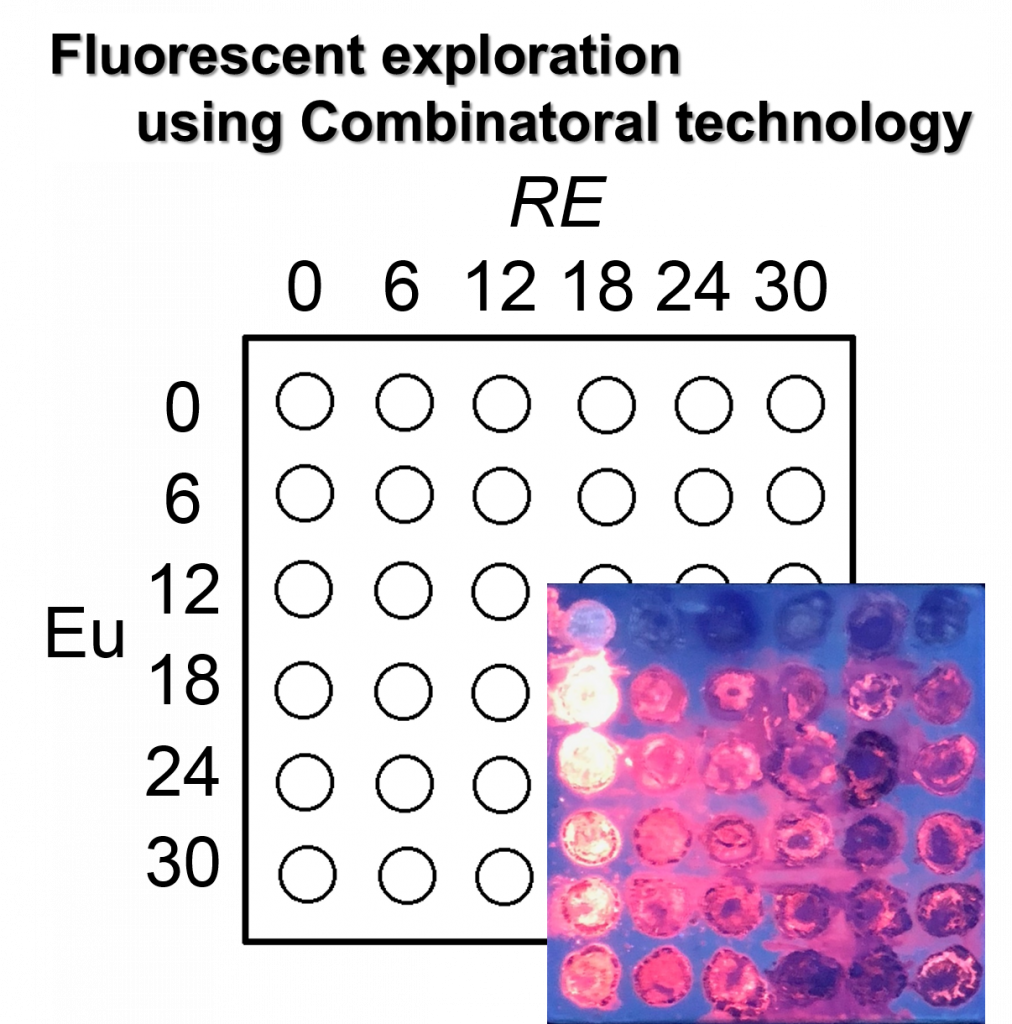
形状記憶および弾性熱量効果を示す合金 _ Shape memory alloys exhibiting elastocaloric effects
1932 年にA. OlanderらによってAu-Cd合金に疑似弾性効果が発見されたことが形状記憶合金の歴史が始まりで、その後、Cu-Zn合金やTi-Ni合金の発見、研究を経てこれらの合金が形状記憶合金と呼ばれるようになりました。形状記憶合金は我々の身近なところで多く使われています。我々はCu-Al系合金に着目し、この系に含まれる弾性熱量効果を活用して、地球温暖化係数がゼロとなる固体冷媒のコア材料の探索を進めています(最近のアウトプットはこちら)。
The discovery of pseudoelastic effects in Au-Cd alloys by A. Olander et al. in 1932 marked the beginning of the history of shape memory alloys. Subsequently, the discovery and study of Cu-Zn alloys and Ti-Ni alloys led to these alloys being referred to as shape memory alloys. Shape memory alloys are widely used in our daily lives. We have focused on Cu-Al alloys and are exploring the use of the elastocaloric effect inherent in this system to develop core materials for solid refrigerants with a global warming potential of zero.
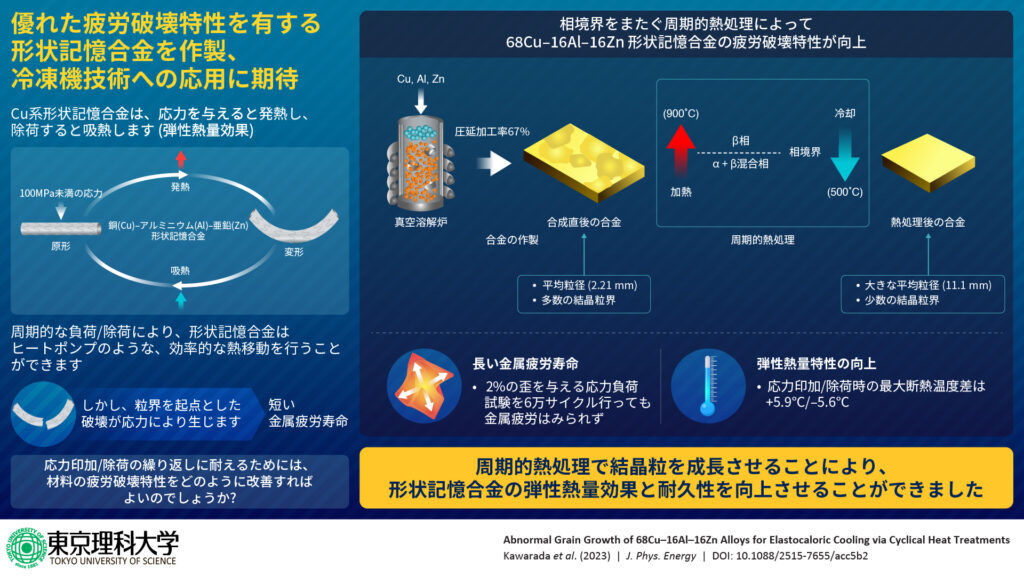
コンビナトリアル材料科学技術(材料高速探索法) _ Combinatorial Materials Science and Technology (High-throughput Materials Exploration process)
コンビナトリアル材料科学技術はハイスループットでの材料探索法であり、その根幹にはノーベル化学賞を受賞したR.Merrifield氏が提案したペプチドの効率的な合成手法、そして同時期に研究が進められていたスパッタリング技術による組成傾斜薄膜の作製などがあります。医薬品開発の分野では既に主流となっている技術です。次世代の機能性金属・セラミックスを高速・高効率で探索するため1990年代から装置開発と材料探索の研究が活発に行われるようになりました。特に薄膜、液体の分野では日・欧・米の研究機関やベンチャー企業がコンビナトリアル装置を用いて多元系の材料探索を進め、近年では得られたビックデータを機械学習へ導入し、材料予測に活用しています。当研究室ではセラミックス粉末における材料合成・評価装置開発から材料探索まで先進的に取り組んでいます。2014年には、常圧から200MPa(2000気圧)まで圧力および温度条件も変化させながら無機材料の高速材料探索ができる装置・冶具も開発しました。これにより材料探索だけでなく、固体の反応性に関する研究の高速化も期待できます。今後も装置開発と材料探索を並行して進めていきます。また、前述の機械学習や計算化学による材料予測の分野をマテリアルズ・インフォマティクスと呼ぶようになっており、我々も研究室の装置で産み出した膨大な材料のデータを元に多元系機能材料の探索スピードを上げることを試みます。
Combinatorial materials science and technology is a high-throughput method for materials exploration, with its core based on the efficient peptide synthesis method proposed by R. Merrifield, who won the Nobel Prize in Chemistry, and the fabrication of composition-graded thin films using sputtering technology, which was developed around the same time. This technology is already mainstream in the field of pharmaceutical development. Since the 1990s, research on device development and material exploration has been actively conducted to rapidly and efficiently discover next-generation functional metals and ceramics. In particular, in the fields of thin films and liquids, research institutions and venture companies in Japan, Europe, and the United States have been advancing the exploration of multiphase materials using combinatorial devices. In recent years, the big data obtained has been introduced into machine learning and utilized for material prediction. Our laboratory is engaged in advanced research and development ranging from material synthesis and evaluation equipment for ceramic powders to material exploration. In 2014, we developed equipment and fixtures capable of performing high-speed material exploration of inorganic materials under varying pressure and temperature conditions from atmospheric pressure to 200 MPa. As a result, we expect to accelerate not only material exploration but also research on the reactivity of solids. We will continue to advance both device development and material exploration in parallel. Additionally, the field of material prediction using machine learning and computational chemistry is now referred to as materials informatics, and we aim to enhance the speed of exploring multi-component functional materials by leveraging the vast amount of material data generated by our laboratory's devices.